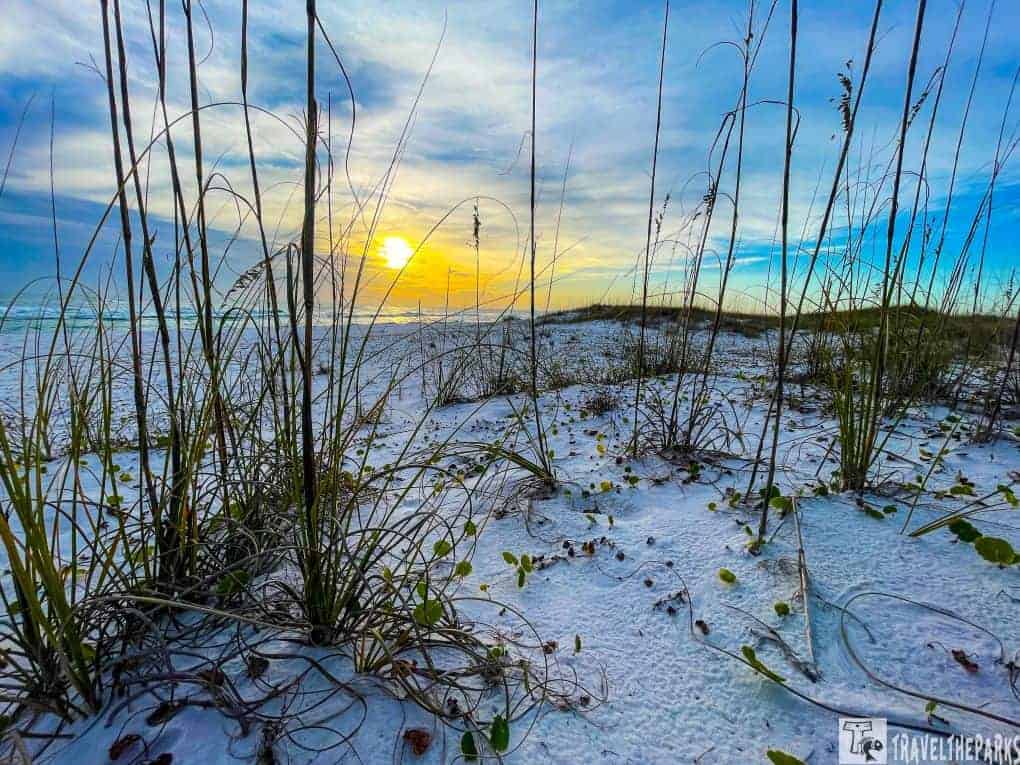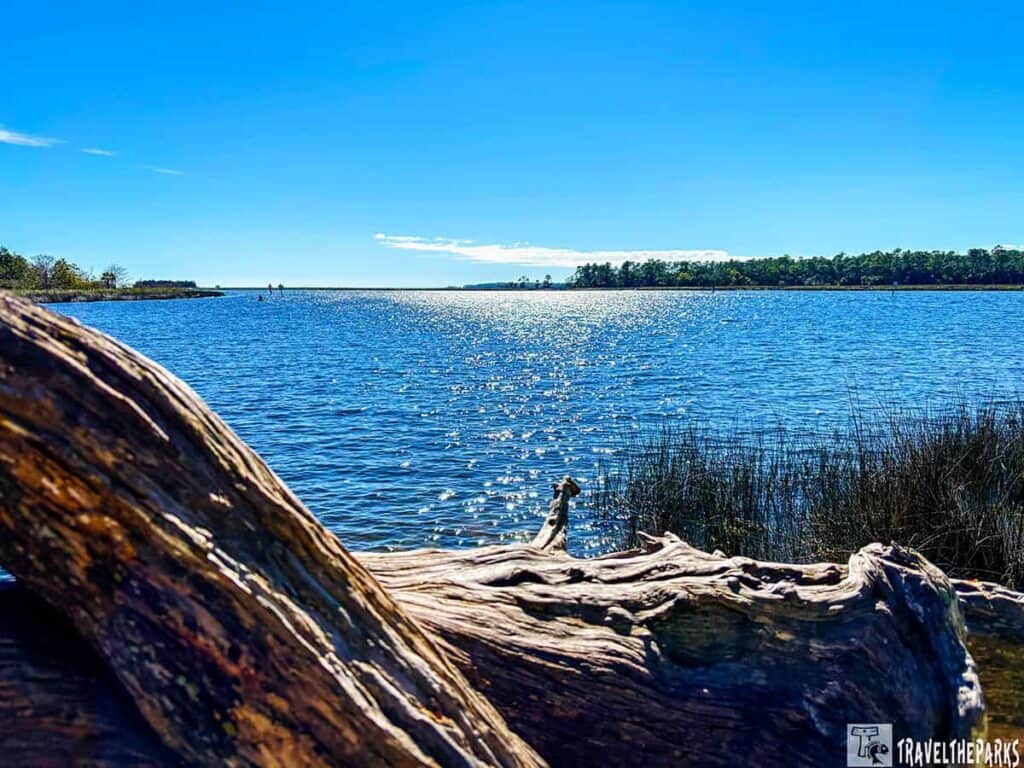Fort Pickens has been on our Florida bucket list for a while, and we were excited to add this stop as part of our Texas road-trip. This fort is one of the most remarkable historical treasures in the Gulf Islands National Seashore. It is at the western tip of Santa Rosa Island, Florida. Engineers built it in the 1830s. Today there is no doubt that Fort Pickens is a prominent tourist attraction just by the sheer number of visitors it attracts yearly. This landmark’s historical significance is open to the public year-round, and guided tours, exhibits, and interpretive programs provide visitors with a glimpse into its history. For us, every camping trip is about exploring new destinations. At Christmas, we visited the Gulf Islands National Seashore to learn about the extraordinary legacy of Fort Pickens. Come explore this remarkable landmark with us.

This post may contain affiliate links, meaning if you purchase something through one of these links, we may earn a small commission at no extra cost to you! Read the full disclosure policy here.
Table of Contents
Fort Pickens: A Gulf Islands National Seashore Treasure: How to Get There
You can get to Fort Pickens in a few different ways. To get to the fort, take Highway 98 south to the Pensacola Beach toll booth. Follow the signs to Fort Pickens by turning left onto Fort Pickens Road. We stayed in Loop A of the campground.
A scenic option for visiting Santa Rosa Island is to take a ride on the Pensacola Bay City Ferry. For a relaxing and unique arrival at Fort Pickens, take the ferry and enjoy spectacular views of the bay. The ferry service also offers optional ranger-narrated cruises and sunset tours. Alternatively, pleasure boaters can access the fort directly by water via Pensacola Bay; a boat ramp is near the fort’s entrance.
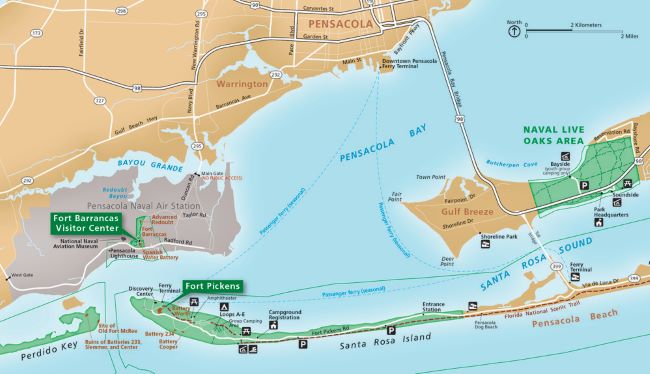
Eco-friendly visitors can also access the fort by biking or walking along the multi-use path that runs along Santa Rosa Island. A short trail from the campground gave us easy access to the park. The Pensacola Beach Trolley operates between Pensacola Beach and the city of Pensacola during the summer, May through September. The Fort Pickens trolley runs on Saturdays, in conjunction with the ferry, making stops at several locations in and around the fort. Day visitors will find ample parking in the many lots close to the fort. Once at the fort, visitors can park in the designated parking areas during daylight hours to explore the area on foot.
PRO TIP: Sometimes delays and cancellations are caused by weather conditions and/or other extreme, unpredictable and unavoidable circumstances.
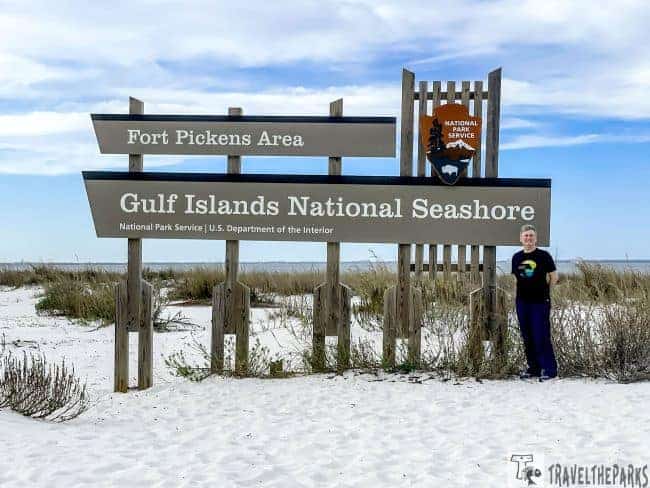
Construction of Fort Pickens: A Fortress of History and Ingenuity
We highly recommend making time on your itinerary to do a ranger-led tour. You will learn all the important facts and information, such as how Fort Pickens was built in a pentagonal shape. It was named after Brigadier General Andrew Pickens, a war hero from South Carolina who fought with distinction during the American Revolution.
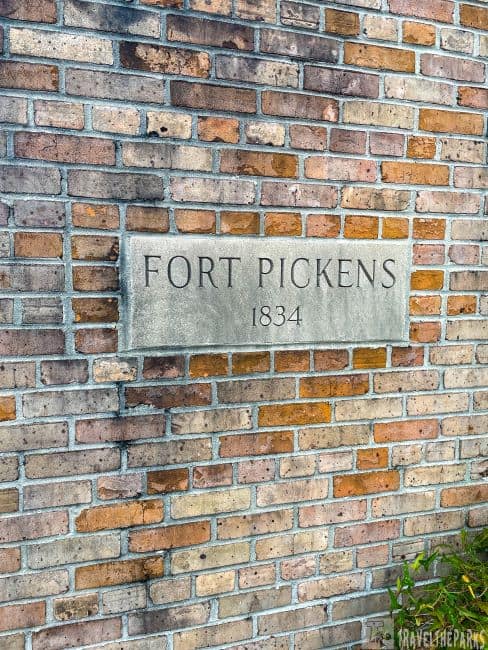
Like the previous forts we have visited, such as Fort Clinch, Fort Pulaski and Fort Jefferson, Fort Pickens is part of the United States’ coastal defense system. This fort’s Third System of Fortifications was designed to defend the United States against coastal attacks. It surprised me with the immensity, as Fort Pickens is quite large. Apparently, this formidable brick fortress is one of the biggest in the system. The walls are 40-feet high and 12 feet thick and used 21.5 million bricks. It took 5 years to complete. That’s pretty impressive.

Fort Pickens: A Strategic Bastion During the American Civil War
Along with Fort Barrancas and Fort McRae, Fort Pickens played a pivotal role in the American Civil War. Understanding the relevance helped us appreciate the role it played during the conflict. Its strategic significance stemmed from its commanding position guarding Pensacola Bay, a vital port city and naval base. Blockading the harbor strangled the opposing forces. In 1861, Confederate forces attempted to capture the fort, but they were unsuccessful. The fort remained under possession of the Union forces for the rest of the war,
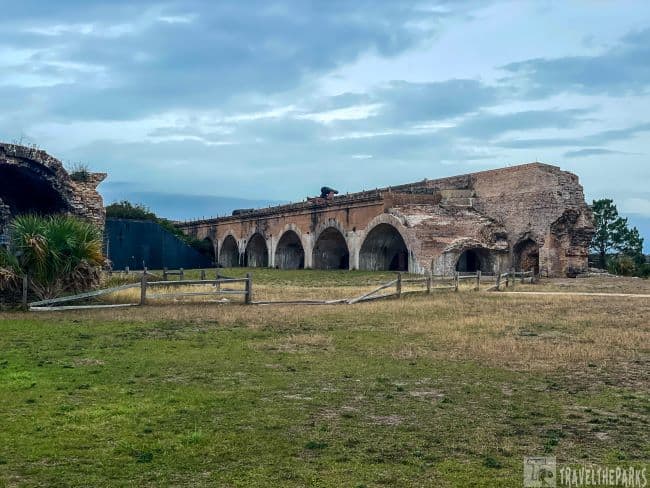
One of the lesser-known facts is that in 1886, Fort Pickens was used as a prison for captured Confederates, political prisoners and Native Americans. Its most famous prisoner was the Apache leader, Geronimo. The Army incarcerated him here until 1888. Much later, during World War II, it became a training facility for the US Army & Navy. In the early 1900s, the military made needed upgrades, including new artillery and fortifications to store ammunition and explosives. However, in 1899, 8,000 pounds of gunpowder ignited and exploded, destroying much of Bastion D. After 118 years of service, the U.S. government decommissioned the fort in 1947. Not too much later, they transferred the fort to the National Park Service and became part of the Gulf Islands National Seashore in 1972.

General Information to know before you go to Fort Pickens in Gulf Islands National Seashore
The park charges an entrance fee, which grants access to the Gulf Islands National Seashore for seven days. The current rates are:
- $15 per individual (pedestrian or cyclist)
- $20 per motorcycle
- $25 per private vehicle
This pass is an excellent value as it includes access to all areas of the Gulf Islands National Seashore, plus Johnson’s Beach in Perdido Key.
For travelers planning to visit multiple national parks, we highly recommend purchasing the America the Beautiful – National Parks and Federal Recreational Lands Pass. It offers tremendous savings if you plan to visit other National Park Service sites within a year.
PRO tip: this is a dog-friendly park! Leashed pets are welcome on trails but are not permitted on the beach or inside any historic buildings.

Fort Pickens Road is a loop road that encompasses the main fort, discovery center, piers and batteries. Numerous pull-offs and parking areas helped us to access the buildings. We opted to begin with the main fort, working our way back towards the campground-loop A.
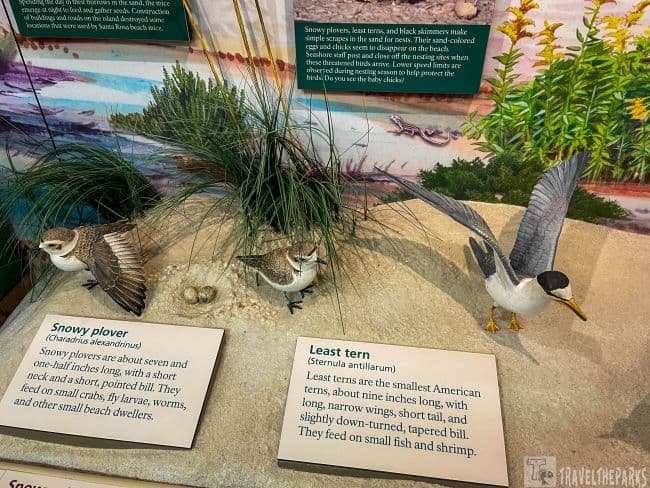
Dive into Fort Pickens History at the Discovery Center
The center has a few different exhibits about the history of Fort Pickens and the Gulf Islands National Seashore. This is where we found our information on a self-guided tour of the fort and got our National Park Passport stamps. We took time to watch “A Fort Pickens Tour,” a 15-minute film that provides a comprehensive overview of the fort’s history. The second film, “Stories of Survival,” is a 25-minute documentary that explores the natural history and cultural heritage of the entire Gulf Islands National Seashore. For the kids, they can earn a Junior Ranger badge by completing activities that teach them about the park’s history, nature, and culture. If you can attend a ranger-led talk. You will learn about different topics related to the park’s history and natural resources. The Fort Pickens Visitor Center is open daily from 9 AM to 4:30 PM, unless closed on Thanksgiving, Christmas, and New Year’s Day.
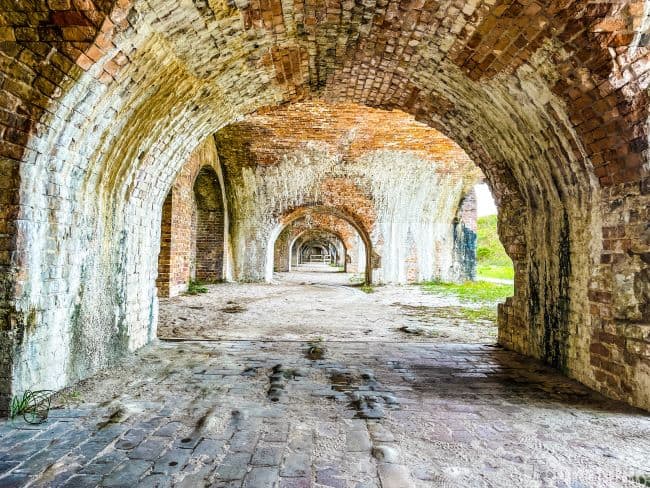
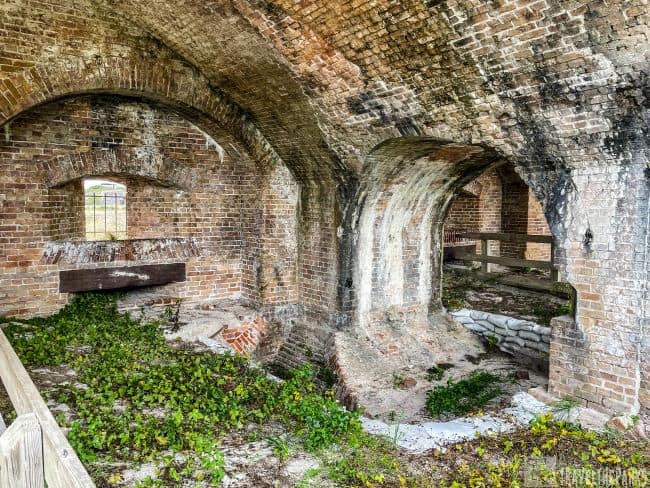
Uncover Fort Pickens’ Secrets: Embark on a Self-Guided Adventure
Starting from the parking area, we followed the sandy path towards the Sallyport. This is where the self-guided tour begins. Interpretive signs and exhibits provide information and context for the 16 stops on the tour. Throughout the tour, there were constant reminders as the walls whispered tales of soldiers, sweat, and sacrifice. In the dim casemates, I imagined grimy hands loading cannons, the air thick with gunpowder smoke.
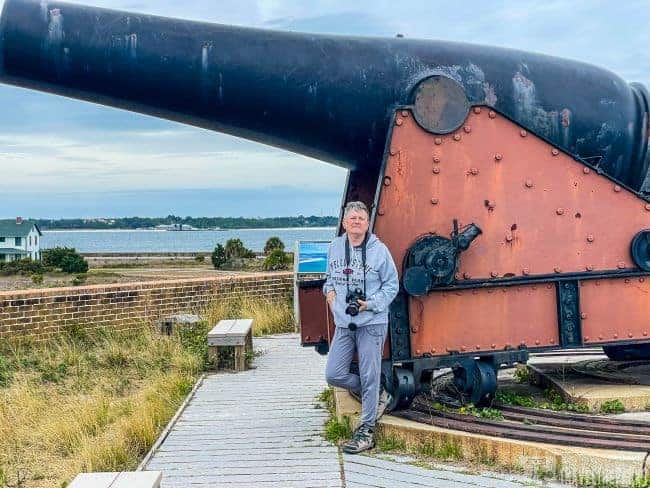
The area also includes the Discovery Center, administration buildings, the wharf area and maintenance facilities. The wharf area includes a fishing pier, ferry pier, jetty, snack bar, and the mine loading and storage buildings. A couple of exhibits in this snack bar/ferry building illustrate the harbor minefield’s design. A bottle refill station sits just outside.
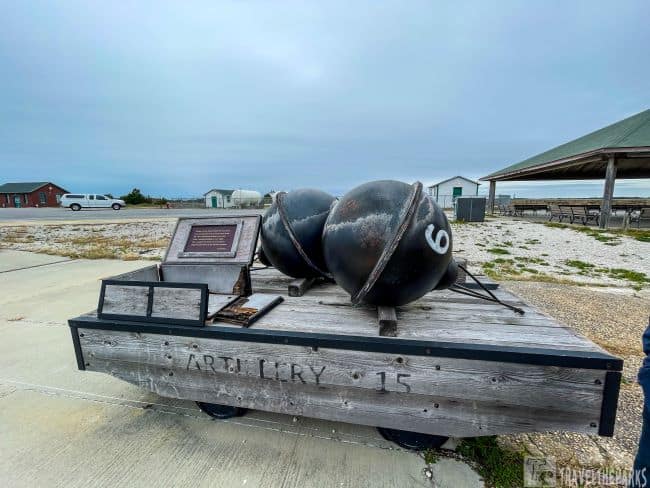

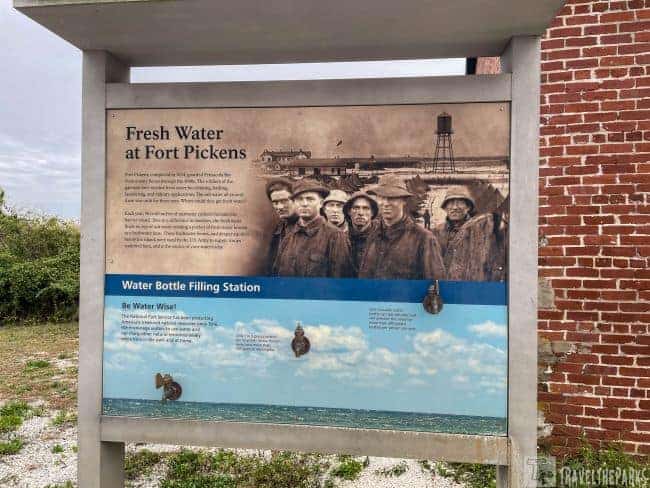


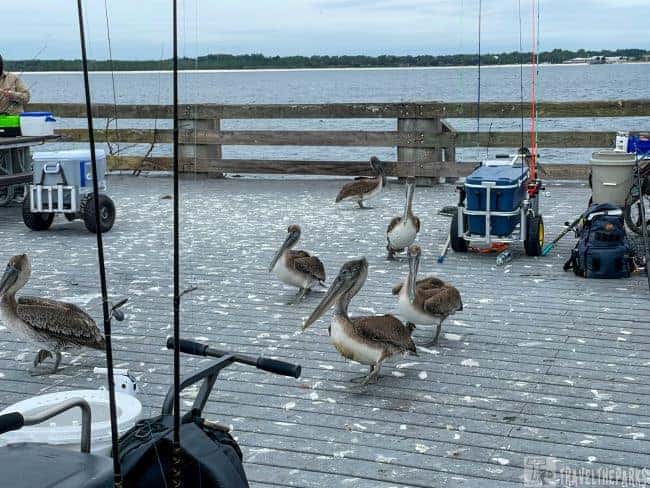
Beyond the Brick Walls: Discovering the Pre-Endicott Era at Fort Pickens National Seashore
Pre-Endicott Batteries (Brick Era 1895-1899):
- Battery Cullum-Sevier (currently closed to the public) surrounded by chain-link fencing, we peeked at the deteriorating remains of this battery. Each had two 10-inch disappearing rifle batteries located on the upper deck. Named after Brigadier General George W. Cullum. In 1916, they split it into two batteries. John Sevier, Tennessee’s first governor, was the inspiration for Battery Sevier. In 1942, workers removed the guns.
- Battery Worth (1899): It had four 8-inch rifles, but later upgraded to two 6-inch disappearing guns. Armed with two 32-pounder mortars, this battery played a crucial role in the Civil War siege. In later years, it became a harbor entrance control post.
- Battery Pensacola, built within the confines of the original Fort Pickens. It featured four 8-inch guns and served as the fort’s main armament during the early 19th century.
- Battery Swearingen (currently closed to the public): built to protect the fort during the war with the Spanish in 1898. It featured two-gun emplacements (4.7 inch). It also stored munitions. The park is working to preserve the battery, which is showing signs of deterioration. In many of the batteries, it was easy to see how water seepage has affected the reinforced concrete walls. They deactivated the batteries in 1921.
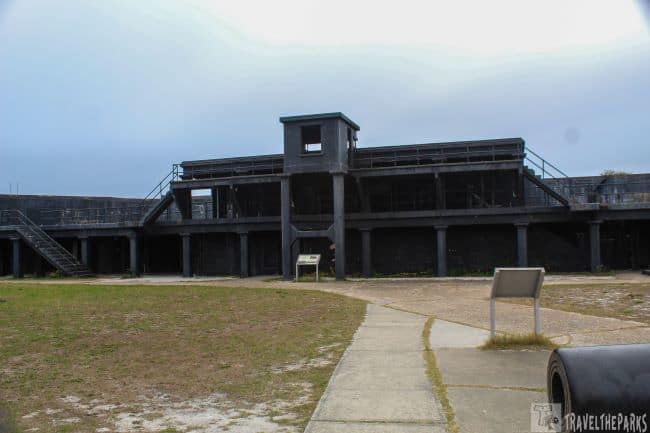
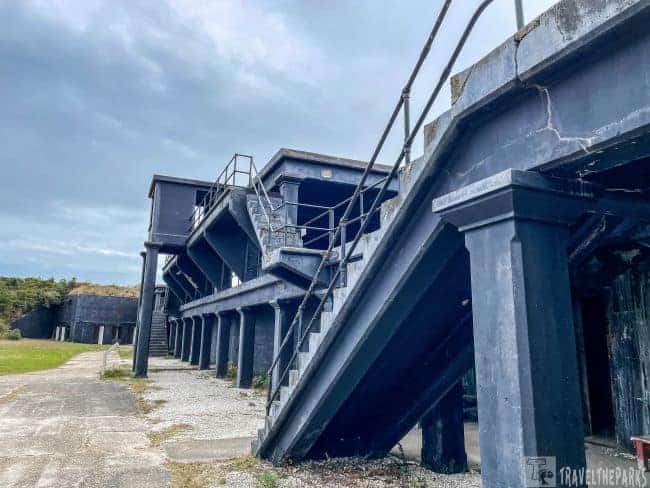
Silent Sentinels 1898-1905 the threat of Minesweeper & Torpedo boats
- Batteries Payne (1904): Looking over the top, we could envision how this battery was used as a harbor defense command post. Hidden in a sand bunker, it was invisible from the beach.
- Battery Trueman (1905): Combined with Battery Payne, this battery provided a 360-degree line of fire to protect the bayside inlet and was also used to store munitions. To us, its eerie black-painted doors gave the appearance of prison cells.
- Workers completed construction of a concrete seawall in 1906, after a hurricane severely damaged the fort. The construction of the 11-foot-high wall took two years. Standing atop the 5 feet wide protective wall, it was easy to see why this structure has withstood the test of time. The well-constructed base of 13 feet continues to protect this low-lying barrier island. Dunes and sea grasses have built up the beach, protecting the inlet.

Walking through these batteries, I closed my eyes, and the whispers became clearer—stories of bravery, boredom, and longing for home. They spoke of men who stared death in the face, of young boys yearning for their mothers’ kisses, and of the quiet resilience of the human spirit. The unimaginable history here is palpable.
We made a quick stop to see the Chasefield Plantation cemetery. Although the original plantation was located across the bay at what is now the Pensacola Naval Air Station, the tombstones were relocated here in 1957. What remains unknown, however, is whether the skeletal remains were moved with them.

Concrete Giants: Standing in the Shadow of Fort Pickens’ Endicott Guns
Walking the sugary sand beaches at Fort Pickens, we never imagined the sheer number of batteries built to sustain and protect the bay. Hidden behind many of the dunes are hulking concrete behemoths. These are the Endicott Batteries, testaments to a bygone era of coastal defense. As we approach the first battery, we notice plants sprouting from cracks and crevices, a testament to nature’s resilience. The Endicott Batteries were a series of modern batteries built in the late 19th century to defend against the threat of new weapons technology. Only three of the original Endicott batteries remained active during the World War II timeframe.

- Battery 234: A seagull crying its lonely song was all we heard as we approached. Built in 1943, this battery is significant for featuring two 6-inch guns on disappearing carriages (placed here by the NPS in 1976). It was strategically disguised as a low hill for camouflage, blending seamlessly into the landscape.
- Battery Cooper (1905–1906): Perfectly hidden in the dunes and painted an ominous black, this battery housed two 6-inch guns and remains remarkably well-preserved. A battery commander’s station stands on the adjacent hillside; we wondered what secrets were hidden behind its door and wished it were open for the public to explore.
- Spotting Tower: Across the street from Battery 234 lies the skeleton of a dismantled radar tower, heavily damaged during Hurricane Ivan. It remains today as a stark, metallic reminder of the ever-present historical threat of invasion.
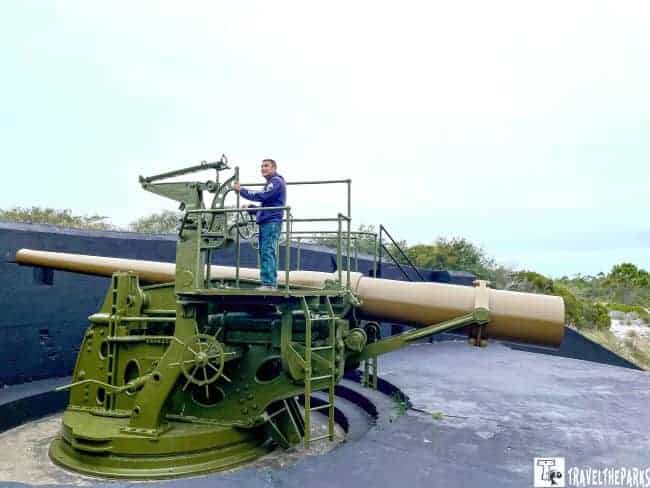
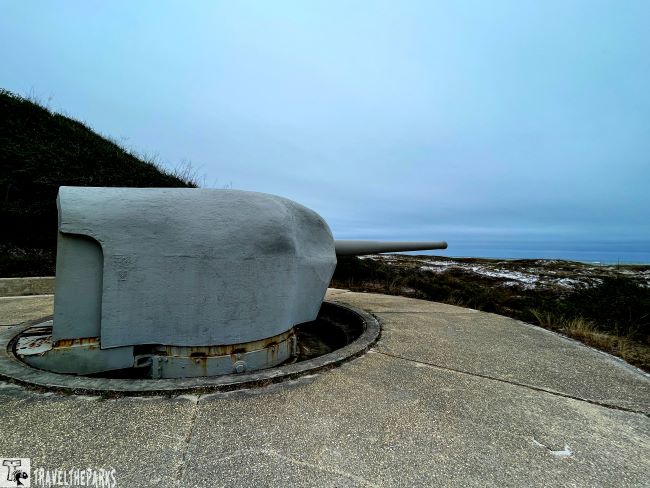
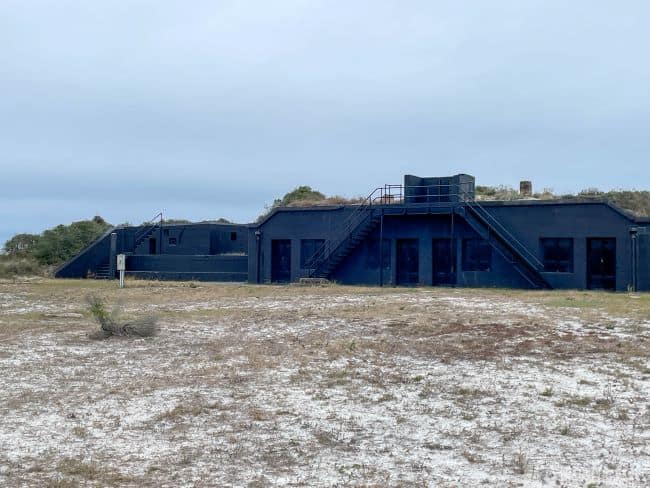
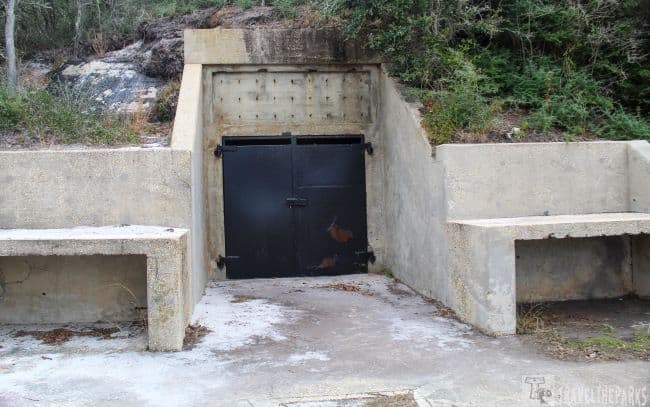
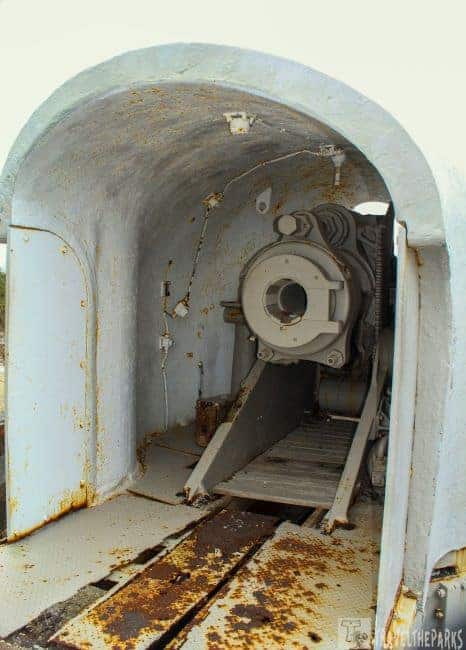
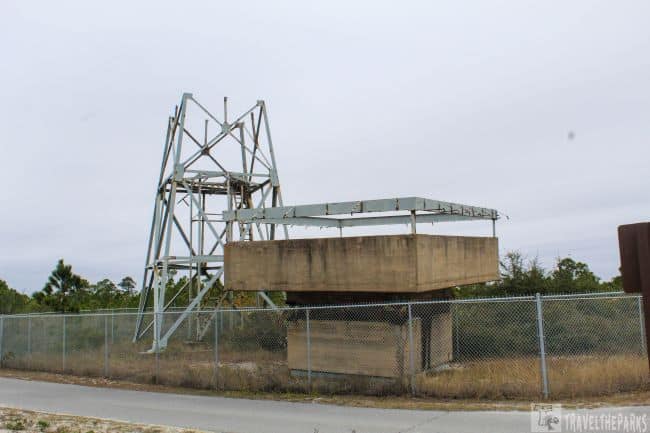
Battery Langdon: A Camouflaged Giant Hidden in Plain Sight
Initially, construction began in 1917. It is the heaviest gun battery at Fort Pickens. It housed two massive 12-inch long guns in open positions, typical of pre-Endicott era batteries. Faced with growing threats, it underwent a significant transformation during World War II. Today, Battery Langdon is completely hidden in a concrete bunker covered with thick layers of earth and vegetation. The camouflage effectively hides the structure from enemy aircraft. This was Sage’s favorite climb in the park. The panorama at the top was breathtaking. On one side, we could see the raging emerald green gulf waters, while the bay side only had slapping waves against the white sugary sand beach. There is no denying how perfect this impressive setting is on this barrier island. Here, under a sky painted with low gray clouds, history wasn’t just words on a page; it was the salt on my skin, the echo in the wind.

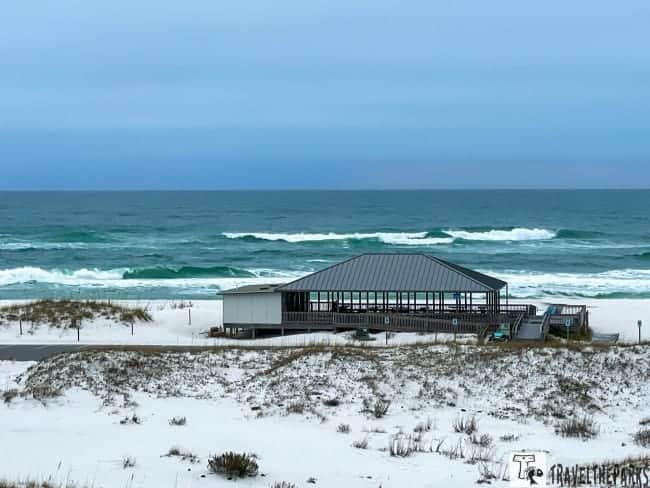

Note: Sand spurs are prevalent on the trail, so we highly recommend dog booties for your furry friend.
Beautiful beaches surround Fort Pickens. Its beaches are known for their white sand and clear blue waters, making it a pretty spot. From the top of the hillside, we had beautiful views of Langdon Beach. Although it is known for its soft sand and calm waters, today is the exception. Usually, it’s a popular spot for swimming and sunbathing. The offshore system has churned up the waves, making it not an ideal beach day.

Hike the Blackbird Marsh Trail, Gulf Islands National Seashore
The Blackbird Marsh Trail is a 1.5-mile loop. Close to our campsite, we walked this well-maintained, easy to follow trail every morning with the dog. It is mostly flat, with a few gentle hills. The trail is also shaded for most of its length, making it a great hike for hot days. The trail will lead you through a marsh, where you can see a variety of wetland birds, such as herons, egrets, and ibis. As we hiked along the trail, it meandered through a scrub forest. Here we could see a variety of trees, including oak, magnolia, and cypress. The trail eventually emerges from the marsh and intersects the Florida National Scenic Trail.
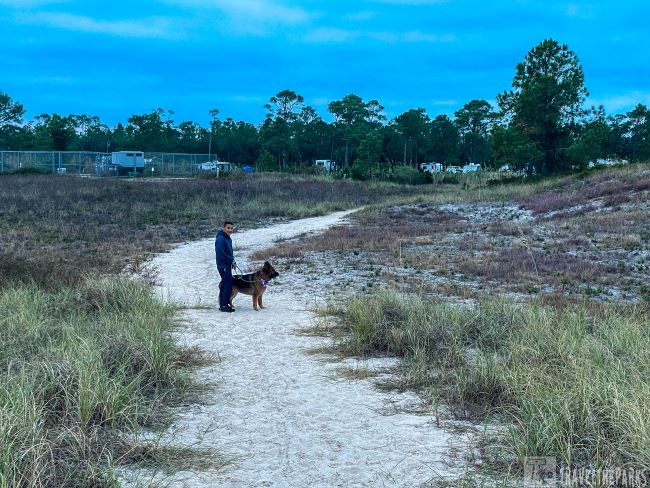
There are several hiking trails on Santa Rosa Island, including the Fort Pickens Nature Trail, which is a 0.9-mile loop trail that takes visitors through the dunes and coastal forest. The trail features interpretive signs that teach about the importance of dunes and how they protect the coastline. Dunes are vital in reducing erosion and storm damage, and they provide habitat for a variety of wildlife.
PRO Tip: Wear comfortable shoes, and bring water and sunscreen, especially if you’re visiting during the summer months.

Beyond the Beach: Discovering the Diverse Trails of Fort Pickens Gulf Islands
The Florida National Scenic Trail passes through the park. There’s a section of the trail that starts right by the fort called the Fort Pickens Trailhead. From there, we moved east towards Perdido Key. No matter how long you hike, you are sure to see plenty of wildlife, including cottontails, migratory wading birds, and, if you are lucky, sea turtles. It’s a beautiful place to get some exercise and enjoy the great outdoors.
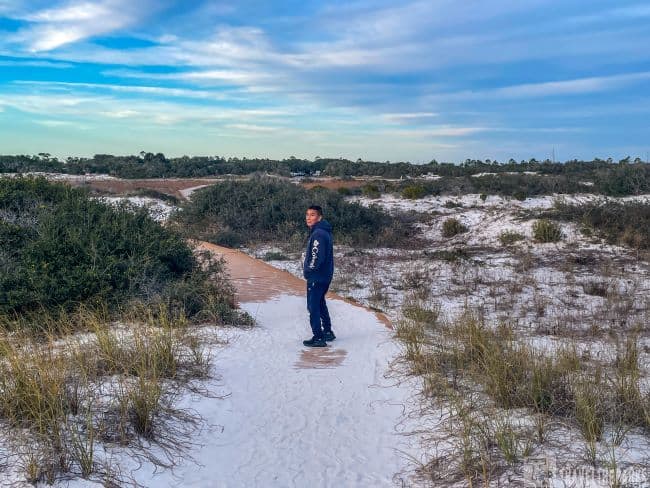
Note: Watch Wildlife. Santa Rosa Island is home to a variety of wildlife species, including sea turtles, dolphins, and shorebirds. Visitors can watch these animals in their natural habitat.
There is also the Opal Beach Trail, which is a 1.4-mile round-trip trail that leads to a secluded beach on the Gulf of Mexico. As we hiked, we enjoyed breathtaking views of the Gulf of Mexico.
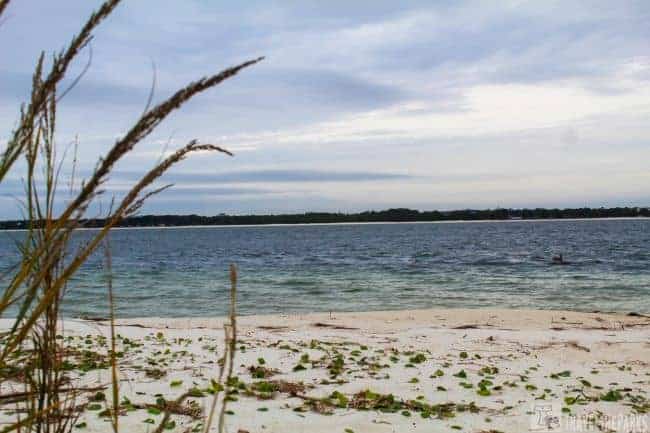
Remember:
- Pack sunscreen, a hat, bug spray and plenty of water to stay hydrated under the Florida sun. A water bottle refill station is near the Discovery Center.
- Wear comfortable shoes suitable for hiking and exploring uneven terrain.
- Be mindful of the delicate coastal ecosystem and practice responsible tourism.
- Leave no trace and respect the historical significance of this national park.
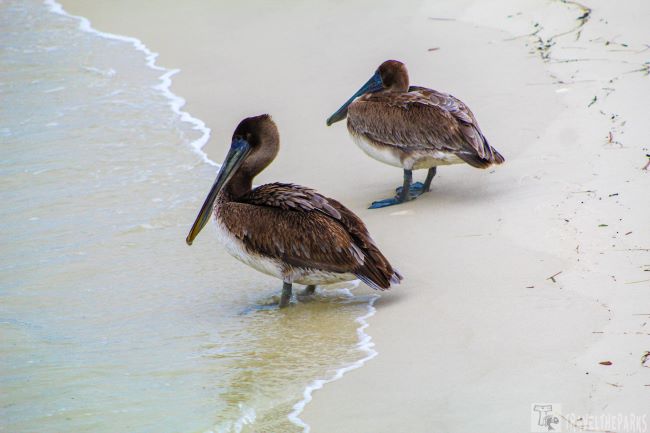
Discovering Adventures: Things to Do at Fort Pickens, Santa Rosa Island
Gulf Islands National Seashore is a veritable paradise for birdwatchers. Park rangers and volunteers have documented over 300 species here. During our early morning walks with the dog, we listen to the melodious calls of catbirds, warblers, and cardinals. My personal favorites are the brown pelicans. Their graceful movements have always fascinated me as their wings skim just above the cresting waves. Along the fishing pier and shoreline, I was even able to capture some great photos of these magnificent birds.

Although we never had an opportunity to paddle among the dunes, renting a kayak or paddleboard here is a fun way to get out on the water. On the bayside, you can paddle through hidden coves where the waterways are more serene. On occasion, you can spot playful dolphins and experience the unique coastal ecosystem from a different perspective.

Hit the beach and unwind on the pristine white sands. During our trip, it was gray, dismal skies with intermittent rain, but that did not stop us from feeling the soft sand between our toes. The high winds made the turquoise waters a bonus for surfers. On clear sunny days, kids can build sandcastles, collect seashells, or simply soak up the sun – the possibilities are endless.
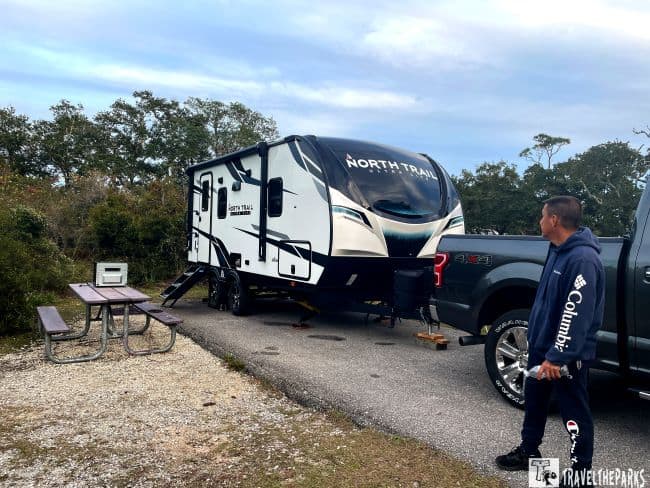
Places to Stay: Gulf Islands National Seashore on Pensecola Beach
While there are no accommodations within the fort itself, there are several options for visitors looking to stay nearby. Here are some of the best places to stay near Fort Pickens:
- RV and Camping: Fort Pickens offers camping and RV sites for visitors. The campground is near the fort and features electricity and water at many sites. I made our reservations online well in advance through Recreation.gov. Site 22 was close to the trails, showers, and restrooms.
- Pensacola Beach: There are several hotels and vacation rentals on Pensacola Beach, which is a short drive from Fort Pickens. The beach offers a variety of options, from luxury resorts to budget-friendly hotels and vacation rentals.
- Gulf Breeze: Gulf Breeze is a small town located just across the bridge from Pensacola Beach. There are several hotels and vacation rentals in Gulf Breeze, offering a quieter alternative to the busier beach area.
- Downtown Pensacola: The city of Pensacola is about 15 miles from Fort Pickens. Downtown Pensacola offers a variety of hotels, bed and breakfasts, and vacation rentals, as well as a lively restaurant and nightlife scene.
Overall, there are plenty of options for visitors looking to stay near Fort Pickens, from camping and RV sites to beach resorts and city hotels.
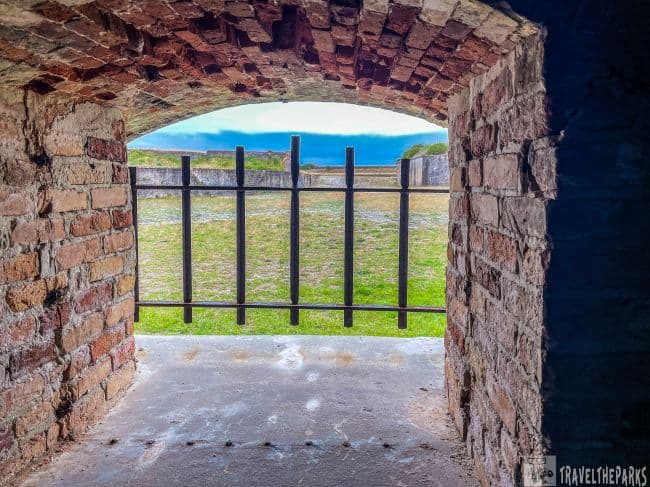
Best Places to Eat: Gulf Islands National Seashore on Pensacola Beach
There are plenty of options for seafood lovers near Fort Pickens, from upscale restaurants to casual beach bars.
- The Fish House: Located in downtown Pensacola, is known for its fresh seafood and waterfront views. The menu features a variety of dishes, including oysters, fish tacos, and seafood platters.
- Peg Leg Pete’s: Peg Leg Pete’s is a prominent seafood restaurant on Pensacola Beach. We enjoyed the fresh seafood dishes, not to mention the drinks. There is also a bar and live music on weekends.
- Flounder’s Chowder House serves a variety of dishes, including chowder, crab cakes, and fish sandwiches. There is also a bar and live music on weekends.
- Casino Beach Bar & Grill provides a variety of casual dishes, including burgers, sandwiches, and salads. There is also a bar and live music on weekends.
- Crabs We Got ‘Em is a local hangout near the beach that serves fresh seafood dishes. The menu also includes burgers, sandwiches, and salads. There is also a bar and live music on weekends.
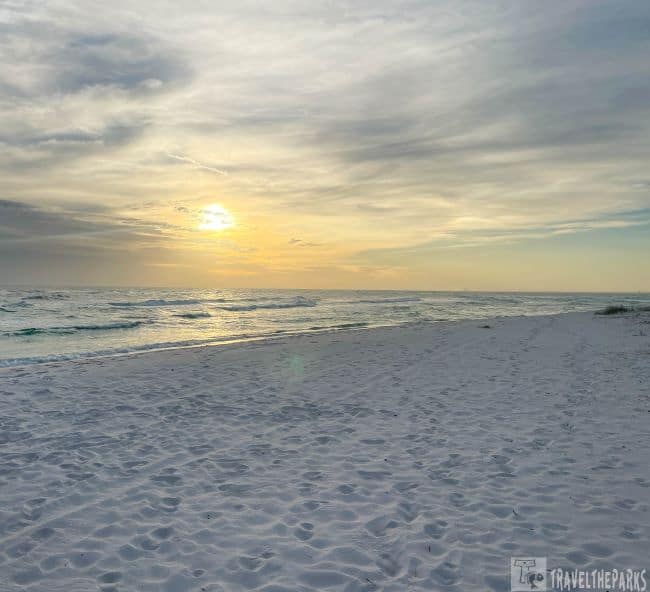
Final Thoughts: Remarkable Fort Pickens: Gulf Islands National Seashore’s Coastal Jewel
This park was just the beginning of our adventures on our Texas and New Mexico road trip. As the sun dipped below the horizon, painting the sky in fiery hues, I knew it was time to leave. But Fort Pickens had cast its spell. It wasn’t just a pile of bricks anymore; it was a living, breathing testament to the past, a silent chorus of echoes whispering in the wind.
So, whether you’re a history buff, a beach bum, or simply curious about the hidden corners of our world, I urge you to take a casual walk through the shadows of Fort Pickens, Gulf Islands National Seashore. The stories you find waiting to be discovered might surprise you.
Have you visited the Gulf Islands National Seashore? Are you interested in the history of Fort Pickens? Share your favorite memory of the park in the comments below.

